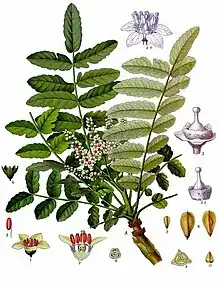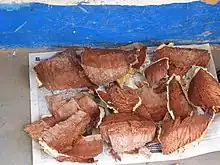| Boswellia | |
|---|---|
 | |
| Scientific classification | |
| Kingdom: | Plantae |
| Clade: | Tracheophytes |
| Clade: | Angiosperms |
| Clade: | Eudicots |
| Clade: | Rosids |
| Order: | Sapindales |
| Family: | Burseraceae |
| Genus: | Boswellia Roxb. ex Colebr.[1] |
| Species | |
|
see Text | |
| Synonyms | |
| |
Boswellia is a genus of trees in the order Sapindales, known for its fragrant resin. The biblical incense frankincense is an extract from the resin of the tree Boswellia sacra, and is now produced also from B. frereana.[3] Boswellia species are moderate-sized flowering plants, including both trees and shrubs.
Description
Boswellia species are dioecious,[4] or hermaphroditic.[5] The flowers may have four or five faintly connate but imbricate sepals with an equal number of distinct, imbricate petals.[4] Also, the stamens, that may contain nectar discs, have distinct glabrous filaments that occur in one or two whorls and in numbers equaling or twice the number of petals; the tricolporate pollen is contained within two locules of the anthers that open longitudinally along slits.[4] The gynoecium contains three to five connate carpels, one style, and one stigma that is head-like to lobed.[4] Each locule of the superior ovary has two ovules with axile placentation that are anatropous to campylotropous.[4] The one- to five-pitted fruit is a drupe that opens at maturity.[4] The endosperm is usually lacking in the embryo.[4]
Taxonomy
The genus name honors Scottish botanist John Boswell, 1710–1780 (incidentally, uncle of writer James Boswell).[6]
The genus was first published in Asiat. Res. 9 on page 379 in 1807.[2]
Species
As accepted by Plants of the World Online;[2]
- B. ameero Balf.f.
- B. asplenifolia (Balf.f.) Thulin
- B. bullata Thulin
- B. dalzielii Hutch.
- B. dioscoridis Thulin
- B. elongata Balf.f.
- B. frereana Birdw.
- B. globosa Thulin
- B. microphylla Chiov.
- B. nana Hepper
- B. neglecta S.Moore
- B. occulta Thulin, DeCarlo & S.P.Johnson
- B. ogadensis Vollesen
- B. ovalifoliolata N.P.Balakr. & A.N.Henry
- B. papyrifera (Del.) Hochst.
- B. pirottae Chiov.
- B. popoviana Hepper
- B. rivae Engl.
- B. ruspoliana Engl.
- B. sacra Flueck.
- B. serrata Roxb. ex Colebr. (type)
- B. socotrana Balf.f.
World Flora Online only accepts 20 species; B. ameero, B. bullata, B. carteri Birdw., B. dalzielii, B. dioscoridis, B. elongata, B. frereana, B. globosa, B. microphylla, B. nana, B. neglecta, B. ogadensis, B. ovalifoliolata, B. papyrifera, B. pirottae, B. popoviana, B. rivae, B. sacra, B. serrata and B. socotrana.[7]

Distribution
The genus is native to tropical regions of Africa and Asia. The distributions of the species are primarily associated with the tropics.[8] The greatest diversity of species presently is in Africa and India.[8] They are native to the countries (and regions) of Assam, Benin, Burkina, Cameroon, Central African Republic, Chad, Eritrea, Ethiopia, Ghana, India, Ivory Coast, Kenya, Mali, Niger, Nigeria, Oman, Senegal, (island of) Socotra, Somalia, Sudan, Tanzania, Togo, Uganda, West Himalaya and Yemen.[2]
Ecological status
In 1998, the International Union for Conservation of Nature (IUCN) warned that one of the primary frankincense species, Boswellia sacra, is "near threatened". Frankincense trees are not covered by the Convention on International Trade in Endangered Species of Wild Fauna and Flora, but experts argue that Boswellia species meet the criteria for protection. In a 2006 study, an ecologist at Wageningen University & Research claimed that, by the late-1990s, Boswellia papyrifera trees in Eritrea were becoming hard to find. In 2019, a new paper predicted a 50% reduction in Boswellia papyrifera within the next two decades. This species, found mainly in Ethiopia, Eritrea, and Sudan, accounts for about two-thirds of global frankincense production. The paper warns that all Boswellia species are threatened by habitat loss and overexploitation. Most Boswellia grow in harsh, arid regions beset by poverty and conflict. Harvesting and selling the tree's resin is one of the only sources of income for the inhabitants, resulting in overtapping.[9]
Frankincense
The four main species of Boswellia, B. sacra (synonyms B. carteri and B. bhaw-dajiana), B. frereana, B. papyrifera, and B. serrata,[3] produce true frankincense, and each type of resin is available in various grades. The grades depend on the time of harvesting, and the resin is hand sorted for quality.
References
- ↑ The genus Boswellia, and the type Boswellia serrata, were first described and published in Asiatic Researches 9: 379. 1807. "Name - Boswellia Roxb. ex Colebr". Tropicos. Saint Louis, Missouri: Missouri Botanical Garden. Archived from the original on July 17, 2017. Retrieved November 24, 2012.
Type Specimens: T: Boswellia serrata Roxb. ex Colebr.
- 1 2 3 4 "Boswellia Roxb. ex Colebr. | Plants of the World Online | Kew Science". Plants of the World Online. Retrieved 16 November 2023.
- 1 2 Tucker, A. (1986). "Frankincense and myrrh". Economic Botany. 40 (4): 425–433. doi:10.1007/bf02859654.
- 1 2 3 4 5 6 7 Judd, W.S., Campbell, C.S., Kellogg, E.A., Stevens, P.F., and M.J. Donoghue. 2008. Plant Systematics: A Phylogenetic Approach 3rd ed. Sinauer Associates, Inc., Sunderland, Massachusetts.
- ↑ Thulin, Mats; Beier, Björn-Axel; Razafimandimbison, Sylvain G.; Banks, Hannah I. (2008). "Ambilobea, a new genus from Madagascar, the position of Aucoumea, and comments on the tribal classification of the frankincense and myrrh family (Burseraceae)". Nordic Journal of Botany. 26 (3–4): 218–229. doi:10.1111/j.1756-1051.2008.00245.x.
- ↑ Quattrocchi, Umberto (1999). CRC World Dictionary of Plant Names: Common Names, Scientific Names, Eponyms, Synonyms, and Etymology. ISBN 9780849326738.
- ↑ "Boswellia Roxb". worldfloraonline.org. Retrieved 16 November 2023.
- 1 2 Weeks, A., Daly, D.C. and B.B. Simpson. 2005. "The phylogenetic history and biogeography of the frankincense and myrrh family (Burseraceae) based on nuclear and chloroplast sequence data". Molecular Phylogenetics and Evolution, 35: 85–101.
- ↑ Fobar, Rachel (13 December 2019). "Frankincense trees—of biblical lore—are being tapped out for essential oils". National Geographic. Archived from the original on December 13, 2019. Retrieved 16 December 2019.